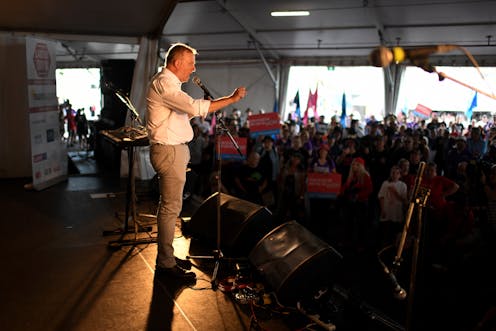Source: The Conversation (Au and NZ) – By David Peetz, Professor Emeritus, Griffith Business School, Griffith University

Dan Peled/AAP
This article is part of The Conversation’s series looking at Labor’s jobs summit. Read the other articles in the series here.
To those old enough, Prime Minister Anthony Albanese’s Jobs and Skills Summit brings back memories of Bob Hawke’s National Economic Summit conference, held the month after his 1983 election victory.
But they are very different animals in very different contexts.
The inflation contexts
In the 1983 summit, the context was high inflation and unemployment, fed by high wages growth. Profits were squeezed. The unions had to be persuaded to restrain wages demands, and the Prices and Income Accord of February 1983 had achieved that. The summit reinforced that consensus.
In 2022, the context is high inflation and low unemployment. Unions are much less powerful than they were in 1983. Rising prices are feeding into rapidly growing profits, and corporations benefit from shortages and market concentration by pushing up prices in numerous areas. That’s how markets work in times of shortages.
Government might like firms to restrain their price demands, but there is no existing agreement about that, and Australian business is not known for engaging in self-restraint when profits and executive bonuses might be at risk.
So the task for Albanese would be much harder than that facing Hawke, if the jobs summit were aimed at inflation. It is not. Its agenda is about full employment, productivity, job security, wages, labour force participation, skills and the labour force aspects of industrial change.
The Albanese government can’t use tripartism (discussions between the government, business and unions) to deal with inflation, the way the Hawke government did. But it needs tripartism to deal with many of those issues up for discussion at the job summit.

National Archives of Australia
The mostly zero-sum issues
On some of the issues, unions have a strong inherent interest. The second of the five headline issues in the Issues Paper is “Boosting job security and wages”.
Unions have some fairly obvious demands here. They want the government to remove some of the legal barriers to collective action. They want it to cut opportunities for employers to use casual labour and contractors in place of permanent employees. They want action to better protect workers in the gig economy. They also want state governments to loosen their salary caps, though that’s not something the federal government can determine.
Read more:
If the PM wants wage rises, he should start with the 1.6 million people on state payrolls
The federal government receives limited support from Treasury, which would vigorously oppose most of the unions’ proposals on tax or economic reform. Treasury still pushes the line (repeated in the summit Issues Paper) that low wage growth reflects low rates of job switching. It is as if low wages growth is workers’ fault for not being adventurous enough.
Treasury’s failure to understand the changing labour market is one reason it has overestimated future wages growth in most budgets since 2015-16. Increasingly, employers have been unwilling to offer wages high enough to get people to switch jobs. Less orthodox economists talked of increasing “monopsony” – a situation where there is only one buyer – in labour markets.
Still, this failure is not fatal, as a Labor government has many sources of advice. So, it can be expected to support some, but not all, of the unions’ proposals. For example, the federal minister, Tony Burke, has already signalled he wants to stop exploitation of loopholes in termination of agreements.
We might also see the federal tribunal given the power to set standards for contractors working in road transport, much as has happened in NSW since 1979 and is now proposed by the Queensland government.
Read more:
Guilt, shame, dissatisfaction: workers and customers on the gig economy (and how to make it better)
These are matters on which consensus is unlikely. They are mostly zero-sum issues: the previous government’s attempts to weaken unions and enable cuts to labour costs did nothing to boost the size of the cake, and reversing them will not change that. After decades of higher profits being gained through lower wages, there is little prospect that lifting wages at the expense of profits would get the support of business.
The positive-sum issues
However, most of the other issues for the job summit are not at all zero-sum, and the government will want all sides to think outside the box and contribute to the solutions. Raising productivity, improving skills and training, having a labour force able to promote and adapt to industrial change, and ensuring an adequate climate and energy “transition” are all matters on which both capital and labour can benefit and contribute.
Unions are explicitly mentioned in the Issues Paper for their potential role in dealing with barriers to employment, migration, training, female employment and regional policy. The government will no doubt seek their views and encourage their further engagement in the issues.
Even though talk of a climate and energy transition is now too optimistic — we are more likely to see a series of disruptions than any smooth transition — the role of unions will be very important here. They will be key to shaping how far and how fast Australia adapts to the changing environment, and the changing demands of our trading partners for action on climate change.
The solutions to these many problems won’t all be found at the jobs summit. But we can expect it will facilitate the establishment of a number of tripartite mechanisms, some formal, some informal, that will guide reform in a number of areas over the next few years.
In that sense, the summit is part of a long game that Albanese is playing. It’s not about short-term theatrics. It is about laying the groundwork for several years of policy development. The unions and the government will both look for co-operation from the other over the long haul.
![]()
David Peetz receives funding from the Australian Research Council and, as a university researcher, has undertaken research over many years with occasional financial support from governments from both sides of politics, in Australia and overseas, employers and unions.
– ref. What can unions and the Albanese government offer each other at the jobs summit? – https://theconversation.com/what-can-unions-and-the-albanese-government-offer-each-other-at-the-jobs-summit-188535







